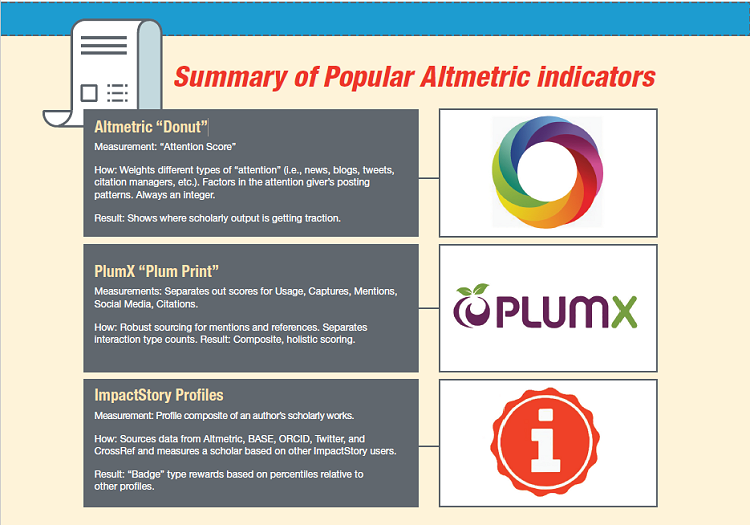Staying Relevant With Measures of Scholarly Impact
By Elaine M. Lasda, Richard P. Hulser January/February 2019 Issue
Not Just for AcademiaMuseums and Other Cultural Institutions’ Use of AltmetricsBy Richard P. Hulser How can cultural institutions and the librarians working in them use impact indicators to their advantage? Bibliometrics have provided one way to show attention and value to scholarly research. The increased volume of published research makes this more challenging all the time. Online and social media platforms have expanded venues for discussion of research endeavors. The advent of altmetrics tools has enabled such discussions to be identified and measured. Scholarly research is often thought of as originating from universities, large companies, and think tanks. Such research is also conducted at cultural institutions, whose focus, whether the subject concentration is art, history, or science, is to help visitors learn about the content and be inspired by the exhibits and programs provided. Research departments within cultural institutions have to continually work on visibility, thereby showing value to the institution, as well as aid in promoting to all the perception of their institution’s value. These departments need measurements to back up statements and reasoning. Researchers associated with these institutions conduct original research that appears in scholarly publications in print and online. These researchers are having similar experiences as their colleagues in academia, as they are now being asked more and more by senior management, grant agencies, and donors to provide evidence that their work is being read, talked about, and is of value based on the money and time spent on it. Altmetrics can help researchers in cultural institutions provide evidence of the expanding online attention to their published work and its value. Use of altmetrics was expanding in academia, but it wasn’t until 2015 that this began happening in cultural institutions. Visitors are a key focal point for museums. Awareness of museum research activities by visitors and potential visitors is an important factor. Use of quantitative metrics such as the number of visitors in a certain time period or the revenue from special exhibits or programs for visitors is one way to measure success. At the same time, the quality of a visit is also important, and that measure is obtained through surveys, observations, and comments from visitors. Similarly, obtaining and understanding quantitative and qualitative measures of museum researcher align with overall museum operations. Bibliometrics provides information on citing of work done by museum-affiliated researchers. Altmetrics enables museum researchers to obtain information on how and where online discussions of research are happening and who is participating in them. This is certainly valuable to the museum researchers who can use such information to support grant applications or other fundraising initiatives. But altmetrics is also useful for marketing and communications purposes. There are tools that do searches and consolidate data that is of interest to marketing and communications departments. These tools will search for mentions of an institution, certain people associated with that institution, or key initiatives. The resulting data is much like a typical online search—a lot of information that takes time to sift through to get to the information deemed most useful. Altmetrics sometimes overlap with those tools, but most often provide information not captured by them. Altmetrics focus only on trackable scholarly research, so the results are more focused. At the same time, if a particular research project is also of high interest—such as the oldest fossil of an animal species—altmetrics won’t capture all the general discussions occurring online, only what is tied to the research article itself. Altmetrics can quickly reveal attention to research articles that, which due to lack of time, did not have press releases sent out from the communications office. The marketing and communications offices can use altmetrics to more easily identify potential future promoters of museum research and activities. Altmetrics can determine origin of a tweet or online posting in another social or online source mentioning a research article, wherever it may be located worldwide. The profile of that poster can reveal that he or she is a research journalist or blogger who may have a large number of subscribers or followers or that it comes from an online news outlet. The profile is useful for marketing and communications to add as a contact to expand awareness of future research results and museum initiatives. 
Additional ResourcesHulser, Richard P. “Altmetrics: Social Media Metrics Tools Expanding the Librarian’s Role,” VALA 2016, Feb. 9, 2016; doi.org/10.6084/m9.figshare.5457289. Kelly, Elizabeth Joan. “Altmetrics and Archives,” Journal of Archival Studies , Vol. 4, 2017 (elischolar.library.yale.edu/cgi/viewcontent.cgi?article=1030&context=jcas). Konkiel, Stacy, et al. Altmetrics for Librarians: 100+ Tips, Tricks, and Examples . Altmetric, LLP, 2016 (altmetric.com/libraries-ebook). Konkiel, Stacy. “How to Make Better Collection Management Decisions by Combining Traditional Metrics and Altmetrics,” Aug. 11, 2016 (altmetric.com/blog/altmetrics-collection-development). Madjarevic, Natalia. “A Practical Guide to Altmetrics for Scholarly Communication Librarians,” Aug. 9, 2016 (altmetric.com/blog/altmetrics-for-scholarly-communication-librarians). Sugimoto, Cassidy R. et al. “Scholarly Use of Social Media and Altmetrics: A Review of the Literature,” JASIST , June 22, 2017 (doi.org/10.1002/asi.23833). Warren, Hannah R. et al. “The Rise of Altmetrics,” JAMA , Jan. 10, 2017, Vol. 317, No. 2, pp.131–132 (doi.org/10.1001/jama.2016.18346). |
 Elaine Lasda is coordinator for scholarly communication and associate librarian for research impact and social welfare, University at Albany, SUNY. Elaine Lasda is coordinator for scholarly communication and associate librarian for research impact and social welfare, University at Albany, SUNY.Richard P. Hulser is president, Richard P. Hulser Consulting.
|